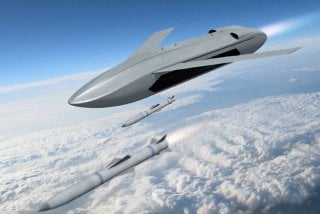LongShot Attack Drone: The U.S. Military's Ultimate Stealth Weapon?
Early conceptual renderings of DARPA’s new LongShot attack drone show what looks like a stealthy platform.
Hiding above advanced enemy air defenses to launch secret attacks, identifying enemy ground and air targets while remaining undetected, transmitting and using AI-generated dogfighting skills to engage and destroy enemy fighter jets with a new generation of air-to-air missiles are all missions the Air Force may likely perform with its newly emerging LongShot air-attack drone.
Early conceptual renderings of DARPA’s new LongShot attack drone show what looks like a stealthy platform, an apparent intent that introduces an entirely new sphere of warzone targeting, surveillance, and attack possibilities. This is particularly true due to its “long-range” technology, as it changes the tactical equation regarding where air-to-air and air-to-ground strikes can strike.
While details regarding the actual technical configuration of the drone are not yet available, as an actual prototype may not exist as of yet, however, both DARPA and Northrop Grumman have released early conceptual renderings of what looks like a stealthy drone. The DARPA effort, which naturally aims to bring ground-breaking attack possibilities to the Air Force, has awarded developmental deals to Lockheed Martin, General Atomics, and Northrop Grumman. Early design work is already underway.
“Northrop Grumman’s contract with DARPA includes designs of LongShot vehicles and operational analysis of the concept. We anticipate DARPA will develop demonstrators or prototypes in future phases of the program,” Jaime Engdahl, program director, kinetic weapons and emerging capabilities, Northrop Grumman, told The National Interest in a statement.
Both the DARPA and Northrop images reveal a smooth, wing-body blended horizontal configuration with few edges, sharp curves, or other protruding structures more likely to generate a radar return signal. The DARPA concept shows a fuselage without rear tailfins, suggesting that engineering work is aimed at architecting something with a low Radar Cross Section. DARPA’s design shows two rear-integrated inlets. Northrop’s concept also shows a rounded fuselage with a large air inlet on top of the fuselage blended or rounded into the body of the drone. While early artistic renderings or design concepts may be devoid of many technical details such as weapons pylons, both Northrop and DARPA’s offered rendering may indeed be intended to operate with an internal weapons bay, as there are no visible weapons-hanging structures beneath the wings.
The most significant question with both designs, which do have protruding wings, is the question of weapons pylons. It is tough to tell from either conceptual rendering if there could be an internal weapons bay, a signature element of stealth aircraft, as the edges and shapes of weapons hanging beneath wings creates a larger RCS or “less stealthy” aircraft more likely to generate more detailed or detectable electronic “pings.”
Perhaps it is intended to incorporate some stealthy characteristics while stopping short of operating at full stealth capacity. Both designs do have narrowly shaped protruding wings, not unlike several stealthy U.S. fighter jets, yet the designs do not resemble the stealthiest platforms in existence such as the B-2 or wider-body blended wings of a B-2 or B-21. These stealthiest platforms, of course designed as stealth bombers not necessarily intended for air-to-air combat, are engineered to elude high-frequency targeting radar as well as more broadly scoped surveillance radar.
Air-to-air attack and air-to-ground missile attack, and quite possibly aerial speed and maneuverability, is of course a clear intent of DARPA’s LongShot, as stealthier drones do exist. Lockheed’s RQ-170 Sentinel, a combat-tested surveillance drone, and Northrop Grumman’s previous, first-of-its-kind X-47B carrier-launched drone are both visibly designed as extremely stealthy platforms. A well-armed, high-speed maneuvering stealthy attack drone represents an interesting new aerial attack paradigm for unmanned systems. Perhaps one reason why it may not need to be as stealthy as something like the X-47B is simply due to the breakthrough “range” of its precision attack weapons, thus the LongShot name.
Kris Osborn is the defense editor for the National Interest. Osborn previously served at the Pentagon as a Highly Qualified Expert with the Office of the Assistant Secretary of the Army—Acquisition, Logistics & Technology. Osborn has also worked as an anchor and on-air military specialist at national TV networks. He has appeared as a guest military expert on Fox News, MSNBC, The Military Channel, and The History Channel. He also has a Masters Degree in Comparative Literature from Columbia University.

